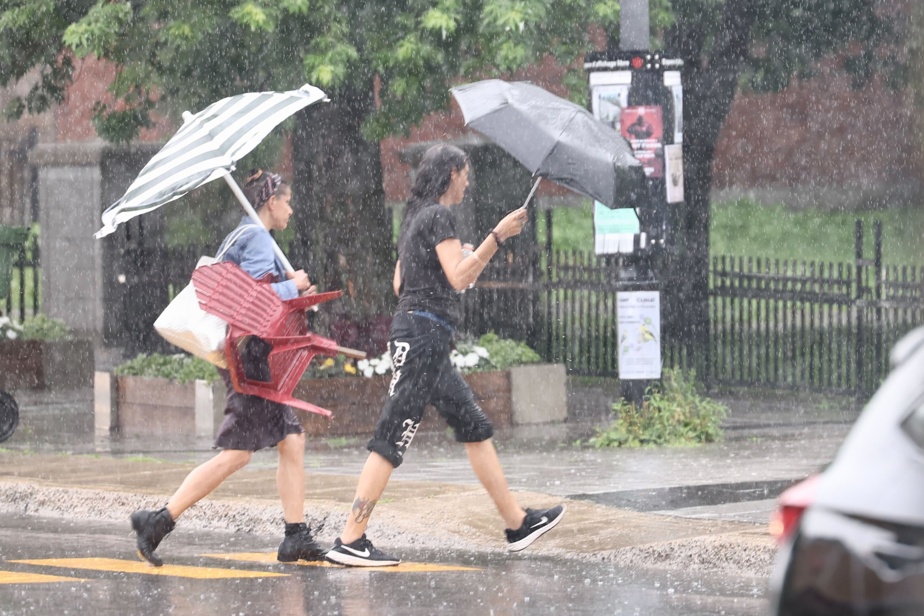What remains of the hurricane Beryl was felt in Montreal, where up to 100 mm of rain fell on Wednesday. While some worried about their homes at the sight of rising water, others, faced with a nightmarish rush hour and closed arteries, struggled to get back to theirs.
Michel Baillargeon, a resident of the borough of Saint-Laurent, was quite scared when he saw the water rising at the corner of Sainte-Croix Street and Lapointe Avenue. Quite scared, because this is not the first time, he says, that the sewer system has not been enough to evacuate the water during heavy rains.
“It’s more than once that there’s water rising in our streets,” he assured. Fortunately, in the evening, when reached by The PressMr. Baillargeon said that the situation had been resolved and that the water which had threatened many homes had been drained.

PHOTO PROVIDED BY JACINTHE MORISSETTE
Some residential streets in the borough of Saint-Laurent were flooded.
“I spent the afternoon helping neighbors and emptying basements. [remplis] “of water,” he said. One house was particularly hard hit, according to Baillargeon: “There was about an inch of water in the entire basement.” It took the drainage system getting working again to finally clean it all up.
Mr. Baillargeon is pleased that he himself was spared – thanks in part to “solid backwater valves” – but he is saddened to see that neighbors have been affected. “The house next door, they’ve been there for two years and this is already their fourth flood.” In addition, with the water backing up, cars have also been damaged. “There was water up to the seats, and then, [les voitures] “couldn’t start,” he says.
The City of Montreal said in the afternoon that it was “monitoring the situation closely.” Hugo Bourgoin, a spokesperson, estimated that due to climate change, “very intense” rains were expected to occur “more frequently.” To become “more resilient,” the city is investing in sponge parks, which reduce the risk of flooding by collecting water that accumulates during heavy rainfall.
Chaos on the roads
The rainfall also gave many motorists and commuters headaches as they returned home.
At approximately 4:20 p.m., the Ministry of Transportation announced the closure of Highway 40, between Highway 13 and Cavendish Boulevard. Highway 15 southbound was also to be avoided since the ramp to Highway 40 was closed.
Highway 15 northbound was also partially closed, and the Sûreté du Québec had to help evacuate motorists trapped in their vehicles.

PHOTO MARTIN TREMBLAY, THE PRESS
Highway 15
To deal with the situation, Quebec opened the emergency measures center for the Montreal region on Wednesday. The government also said it had counted “several abandoned vehicles, but no injuries.”
The situation was not necessarily better for people who had opted for public transportation, like Alexandra Moledje. On board line 174 east, which runs on boulevard de la Côte-Vertu, the journey that usually takes her about twenty minutes quickly became interminable. “The bus was 45 minutes late. […] He was just around the corner, but he couldn’t move forward,” she said.
Une fois à bord, il lui a fallu « plus d’une heure » pour se rendre à destination, le tout alors que « l’eau entrait par le bas des portes » pour s’infiltrer dans l’autobus, qui roulait « très, très lentement ». « On passait à côté d’autos coincées dans l’eau », explique-t-elle encore.
La Société de transport de Montréal (STM) avait prévenu que certaines lignes de bus seraient déroutées et que des retards « pourraient survenir ».
« Exceptionnel »
En soirée, Environnement Canada signalait des précipitations variant entre 50 et 80 mm dans ses stations montréalaises. Toutefois, selon la météorologue Catherine Vallières, Montréal pourrait avoir reçu jusqu’à 100 mm de pluie par endroits. « On peut dire que c’est quelque chose qui arrive assez rarement. Cent millimètres, à Montréal, c’est exceptionnel », affirme-t-elle.
Elle précise par ailleurs que ce n’est pas l’ouragan Béryl qui s’est abattu sur la métropole québécoise, mais bien les « vestiges » de celui-ci. « Ce n’est pas Béryl en tant que tel, car le système a perdu toutes ses caractéristiques d’ouragan. C’est plutôt un système qui s’est reformé à partir de la masse d’air gorgée d’humidité [qu’il transportait]. »
Further north, in Lanaudière, precipitation was heavy, but significantly less, with some 35 mm recorded, a figure similar to that recorded in Vaudreuil.
But while Greater Montreal was the most affected region on Wednesday, the system was expected to move overnight to reach the Richelieu Valley, Drummondville, Estrie and Beauce, where 30 to 40 mm of rain could fall. The threat of showers will still loom this Thursday, but they are expected to be “less well organized.”
The system is expected to leave areas monitored by Environment Canada for good on Friday.
